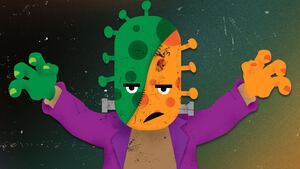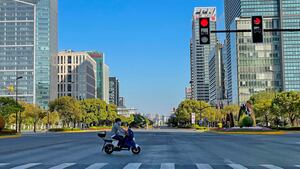The COVID-19 wave crashing across China right now not only threatens the 1.5 billion people who live there. It also poses a serious danger to the rest of the world.
Leaving aside the risk to already fragile global supply chains, there’s a chance that the surge of infections in China will give the SARS-CoV-2 pathogen ample opportunity to mutate into some new and more dangerous variant. If that happens, the progress the world has made against COVID since vaccines became widely available in late 2020 could slow, if not reverse.
“There’s the distinct possibility that things will get out of control in China,” John Swartzberg, a professor emeritus of infectious diseases and vaccinology at the University of California-Berkeley’s School of Public Health, told The Daily Beast. “If that happens,” Swartzberg added, “there will be a remarkable amount of viral reproduction occurring in people and this will increase the possibility of problematic variants being produced.”
Experts disagree just how likely it is that the next major variant—“lineage” is the scientific term—might emerge in China. Ben Cowling, a professor of epidemiology at The University of Hong Kong, said the next major lineage may come from countries where the virus has already swept through the population. Somewhere in Europe, or the U.S.
But there are unique dynamics that boost the chances of a new SARS-CoV-2 lineage appearing in China. The Chinese population is huge—and might be way less protected against infection and thus viral mutation than, say, Americans or Europeans.
This disparity is partly the consequence of China’s earlier success against COVID. For more than two years, the Chinese government and health establishment managed to suppress the novel coronavirus. This despite the pathogen likely originating at a meat market in Wuhan in east-central China in late 2019.
Thanks to China’s frequently severe limits on crowds and travel daily, the country went two years with practically no COVID. Yes, there were a few tens of thousands of cases across the vast country during the initial wave of infections in the spring of 2020. But after that, almost nothing. So few cases that the 150 or so daily new infections authorities logged in mid-January 2021 qualified as a surge.

There are few people on the subway in Xi’an, Shaanxi Province, China, April 16, 2022.
Costfoto/Future Publishing via Getty ImagesThen came Omicron. The new lineage, which first appeared in South Africa last fall, is by far the most transmissible. Some experts described the earlier form of Omicron, the BA.1 sublineage, as the most contagious respiratory virus they’d ever seen, owing in part to key mutations on the spike protein, the part of the virus that helps it grab onto and infect human cells.
The BA.2 sublineage that soon replaced BA.1 is even worse: potentially 80 percent more contagious than BA.1. There’s also a very rare “recombinant” form of Omicron called XE that combines the qualities of BA.1 and BA.2 and might be 10 percent more transmissible than even BA.2.
BA.1 and BA.2 shrugged off China’s strict social distancing. Even the most fleeting contact between family members, neighbors and coworkers was enough to ignite a viral firestorm in China starting in January.
Omicron struck the southern city of Hong Kong first, then neighboring Shenzhen a few weeks later. After that, the Omicron wave spread to Shanghai, farther to the north, prompting the government to impose one of its strictest, and most controversial, lockdowns yet.
The virus kept spreading. By early April officials were logging an average of around 15,000 new cases a day. A spike in deaths followed. In Hong Kong alone, nearly 9,000 people have died since mid-February. To be clear, that’s a fraction of the infections and deaths that countries with fewer restrictions tallied during the worst of their own COVID surges. What’s so worrying in China is the trend—and the potential for cases, and deaths, to keep going up and up.
And not everyone trusts the official numbers. Chinese cities other than Hong Kong have yet to report COVID deaths from the current wave, leading some experts to ask whether the government in Beijing is deliberately delaying the data in order to mask the extent of the crisis. “I’m skeptical about the death rate reported in China,” Peter Collignon, an infectious disease expert at the Australian National University Medical School, told Bloomberg.
Paul Tambyah, president of the Asia Pacific Society of Clinical Microbiology and Infection in Singapore, told The Daily Beast there could be some under-reporting by health officials, but probably not enough to truly alter our understanding of the Chinese outbreak. “The active Chinese social media scene, which has broadcast images of individuals chafing under lockdown restrictions, is unlikely to have missed large numbers of severe cases or deaths,” Tambyah said.
Still, the COVID wave in China is bad—and getting worse—at the same time cases hover at a year low across much of the rest of the world, despite BA.2 becoming the dominant sublineage almost everywhere.
“It could be that we are seeing the resurgences in China, including the emergence and spread of new sub-strains, primarily because the population there never achieved high levels of natural immunity,” Edwin Michael, an epidemiologist at the Center for Global Health Infectious Disease Research at the University of South Florida, told The Daily Beast.
You can’t build up natural antibodies across a large population if no one is ever exposed to the virus. That’s the downside of total lockdowns. The antibodies in recovered COVID patients lend strong immunity that, combined with vaccinations across large groups of people, can help blunt the impact of a new lineage. Michael for one said he believes natural immunity is stronger and longer-lasting than immunity resulting from even the best messenger-RNA vaccines.
Not that everyday Chinese people have access to the mRNA jabs. Chinese authorities loudly criticized, then banned, Western vaccines, apparently in order to protect the market for locally made jabs. But experts disagree how effective and long-lasting China’s domestic Sinopharm and Sinovac vaccines are. Tambyah said there’s enough data to conclude the Chinese shots are “highly effective at preventing severe illness and death.”
Michael said he disagrees. “They also used inactivated viruses in their Sinovac and Sinopharm vaccines, which I had expected to be more robust than mRNA vaccines in terms of producing a more diversified immune response that could counter new mutants, et cetera,” Michael said, “but apparently it would seem that this response has waned, making people susceptible again to new strains.”
But even if they are reasonably effective, the vaccines are unevenly distributed in China. The government’s attacks on foreign jabs has had the effect of encouraging anti-vax attitudes, especially among older Chinese who might be less media-savvy than their younger counterparts. So while 85 percent of all Chinese have gotten jabbed, just half of the most vulnerable age group–over-80s–are fully vaccinated. That plus the lack of natural immunity has left millions of people exposed to aggressive lineages that can punch right through lockdowns.
Not only are millions of Chinese at risk of serious illness or death, they’re also potential incubators for potentially worse forms of SARS-CoV-2. “Any place can be a source of new variants, but those places with low levels of population immunity and unchecked spread of the virus are the most likely,” Amesh Adalja, a public-health expert at the Johns Hopkins Center for Health Security, told The Daily Beast.

Hong Kong residents line up to receive their free COVID-19 vaccination.
Photo by Ben Marans/SOPA Images/LightRocket via Getty ImagesEach individual infection, unchecked by antibodies, tends to produce two mutations every two weeks, Niema Moshiri, a geneticist at the University of California, San Diego, told The Daily Beast last year.
“What if we had 50 million people pull slot-machine levers simultaneously at the same time?” Moshiri asked. “We would expect at least one person would hit the jackpot pretty quickly. Now, replace the slot machine with ‘clinically meaningful SARS-CoV-2 mutation,’ and that’s the situation we’re in.”
All that is to say, the longer COVID rates remain high in the world’s most-populous country, the greater the chance that the next major lineage will be Chinese. New lineages are inevitable from one country or another, of course. The trick is to slow the rate of mutation so that fresh vaccine formulations, therapies and public-health policies can at least keep pace with major changes in the virus.
That’s hard to do when the pathogen is spreading fast in a country of 1.5 billion people with uneven rates of vaccination by potentially low-quality jabs and very little natural immunity to back up the shots.
It appears a Chinese meat market was the very first “laboratory” for SARS-CoV-2. The first place the virus could spread and mutate until it became the fast-moving, deadly pathogen the whole world now struggles with. It’s possible some Chinese city—locked down but still ripe for viral transmission—could be the lab for the next major form of the same pathogen. It could be even more transmissible than BA.2. Or maybe it will have some ability to evade natural and vaccine-induced antibodies. It could have both dangerous qualities.
Regardless, that lineage, whether it first appears in China or somewhere else, could prolong the pandemic into its fourth year.








